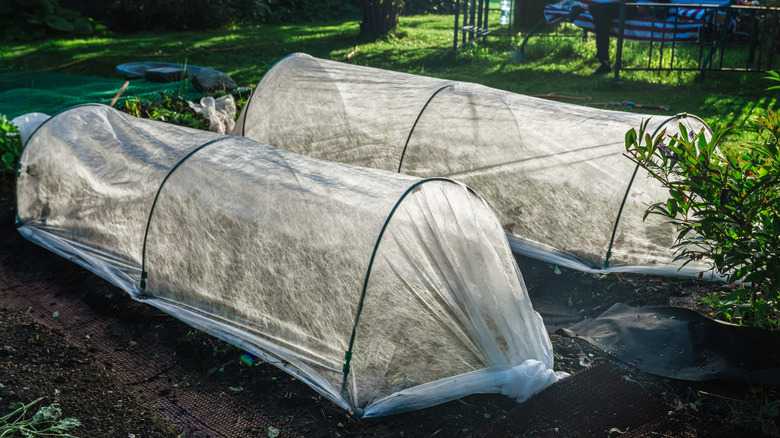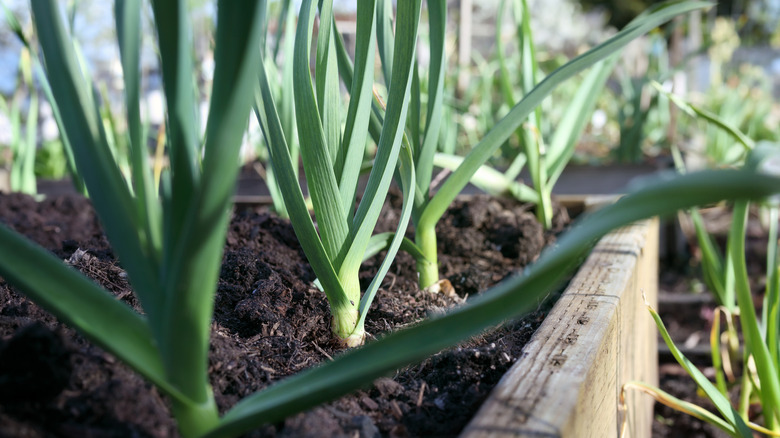10 Veggies You Can Easily Propagate From Cuttings In The Winter
There are many perks to growing plants from cuttings, such as the fact that they can usually flower and mature at a faster rate than plants grown from seed. Additionally, this creates a copy of a plant, so if you like the original produce or flowers, you're going to be able to recreate the same characteristics with the new growth. You can propagate more than just florals and fruits from cuttings, though. There are also quite a few vegetables that work the same way.
Unlike some other plants, the way you propagate veggies from cuttings can sometimes be done with scraps of the vegetable, though some still need proper stem cuttings directly from the plant. For scraps, you can take the parts that you would normally cut off and discard, like the tops of carrots or the very bottom of leeks, to produce edible greens. It's a great way to reduce waste and allows you the chance to get more food out of your garden without having to rely on produce from the stores all the time.
Most of these vegetable stem cuttings you can even start in the winter. In fact, because most of them work best when you let them grow in water for a while to produce roots and new leaves, you can keep them inside for the coldest parts of the year. However, there are also some plants, such as leeks, broccoli, and kale, that can handle cooler weather and be grown outside in the winter just fine, depending on your zone.
Spinach
Spinach is a hardy plant that does well in USDA zones 3 through 11. This leafy green is somewhat difficult to start from seeds unless you are direct sowing, but you can get similar results from stem cuttings that have leaf nodes. All you have to do is cut several healthy stems directly from the plant, and put them in a glass or jar of water for about 10 days. Once roots have formed on the stems, you can put them in soil in a pot, and eventually plant them in the garden.
Turnips
While you cannot regrow turnip roots from scraps, you can produce a bountiful harvest of the greens by cutting about an inch off the top of the root (the part you probably cut off anyway), trimming back the leaves, and placing this in a saucer of water until roots begin to form, which should take about a week. Make sure to change the water every couple of days and don't allow it to dry out. Once some roots have formed, plant the turnip top into a container filled with potting soil, so that the leaves will start to grow.
Onions
While many people grow onion greens indoors from scraps (just like the turnip tops, except in a glass of water), onions that are planted in the ground will often produce side shoots or little green bulbils. These can be removed, planted in a pot, and can grow into regular onion bulbs. This method is often referred to as division, rather than growing from cuttings. It allows you to get multiple onions from one plant. There is even a budget-friendly Dollar Tree bucket that's great for growing onions to make the whole process even simpler.
Brussels sprouts
Although it's not a conventional way to grow Brussels sprouts, to grow these from cuttings, you have the option to start with the sprouts themselves or the stalk, depending on what is available. Of course, you can also try both and see what works. For growing from sprouts, trim off the base and remove any yellowing leaves. Place it cut side down in a saucer of water and roots should form. For the stalk, cut off a section that has nodes and put it in a glass of water. Once roots have formed, plant into a pot.
Kale
Kale thrives in cold weather, and the more frost it gets while growing, the better and sweeter the taste. You can easily start this plant from stem cuttings. All you need to do is find a healthy side stem growing on the main plant and cut it off, close to the main stalk. Trim off the lower leaves but keep the leaf right at the top, just like you would with other types of stem cuttings. Put your cutting into a pot filled with potting soil and keep it in a warm spot.
Garlic
While it's not possible to grow garlic bulbs from stem cuttings, you can grab a bulb you already have, divide it into individual cloves, and plant these into pots filled with potting mix. Each clove should produce a new plant. Whether it's a hardneck or softneck variety, you can grow these on a windowsill and even harvest some of the greens to use in your cooking. If you're short on time, you can just plant the whole bulb in a larger pot and end up with multiple shoots to harvest for greens.
Broccoli
Broccoli enjoys cold weather and is able to handle frost without much of an issue. If you already have some broccoli growing in your garden, you can easily propagate this plant from stem cuttings. Just cut off one or more of the side shoots, making sure that each cutting has some leaf nodes. Remove the lower leaves and place your cuttings either in a jar of water or a container filled with potting mix. It should only take a few weeks for roots to form.
Carrots
Carrots are another vegetable you can regrow from cuttings, or more precisely, the scraps. However, this won't allow you to grow more carrots, just the green carrot tops. So if you like these pretty greens in meals or to make pesto, all you have to do is cut off the top inch of the root veggie, remove the greens if there are any, and place it in a shallow tray of water. In just a short space of time, the greens will shoot up again.
Celery
Celery thrives in many winter gardens if given lots of love, and is hardy in zones 2 through 10. If you love to use the green leaves, you can easily regrow celery from a harvested bunch. Just cut off the base and stick it in water so it's partially submerged until it starts to produce new top growth. While celery is a popular veggie that is no easy feat to grow in your garden, you can have lots of extra greens with this method.
Leeks
Traditionally, leeks are hardy from zones 5 to 9, but certain varieties have allowed them to expand their range. These are another vegetable that will regrow if you just put the base (complete with roots) into water or plant it in a soil-filled pot. You want to ensure that you have around 1 inch of the base of the stem intact. It shouldn't take long for the green growth to commence from the top, and additional roots to also grow.










